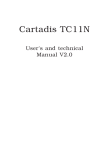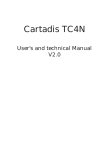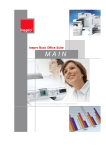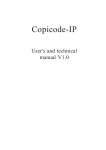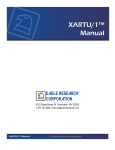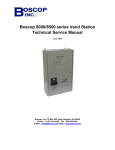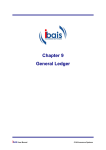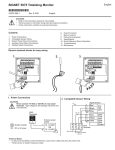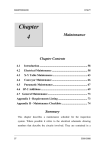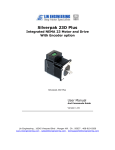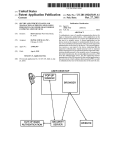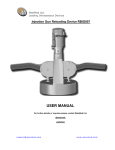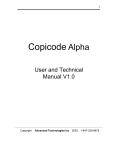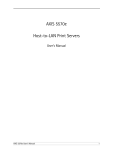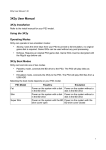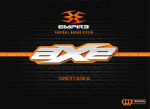Download D:\Cartadis\TC11N\GB. TC11N=0.p
Transcript
TC11N User and Technical Manual V1.0 Copyright Advanced Technologies Inc. 2003 / 1-847-329-9875 TABLE OF CONTENTS SECTION PAGES USER'S MANUAL 1. INTRODUCTION ......................................................................... 3 2. GENERAL PRINCIPLES 2.1. Functions ..................................................................... 2.2. Description of cards ..................................................... 2.3. Examples of use ........................................................... 4 4 5 7 3. TC11N AND ITS USERS .............................................................. 8 4. TC11N AND ITS ADMINISTRATOR 4.1. Sequence of menus ....................................................... 4.2. Recording magnetic cards ............................................. 4.3. Statistics counters ........................................................ 4.4. Price setup and maximum value ..................................... 4.5. Group number setup ..................................................... 4.6. Language ...................................................................... 4.7 User card automatic ejection ....................................... 4.8 Functioning mode .......................................................... 4.9 Beep / Eject if Err. .................................................... 4.9.1 Beep ................................................................. 4.9.2 Eject if Err. ...................................................... 10 12 12 15 17 19 22 22 22 23 23 23 5. TC11N AND ITS OPERATOR ...................................................... 24 TECHNICAL MANUAL 6. INSTALLATION 6.1. Mechanical attachment .................................................. 6.2. Electrical connection .................................................... 6.3. Oversize or color copies ............................................... 6.4. Other copier parameters ................................................ 27 27 27 30 30 7. 8. 9. 10. SERVICE ....................................................................................... TROUBLESHOOTING ................................................................ LIST OF MESSAGES ................................................................... TECHNICAL SPECIFICATIONS ................................................. 33 35 38 40 1 INTRODUCTION Thank you for your choosing Advanced Technologies' equipment to manage and control access to your copier. The TC11N enables you to manage and control a copier by means of magnetic cards. These cards must be initialized either on the unit itself (by the person in charge of the copier) or bought from an automatic dispenser / reloader (the DRC4). If you've purchased more than one TC11N, they are incompatible by default, meaning that cards issued on one unit cannot be used on another. A procedure to make the TC11Ns compatible with each other can be performed, and once completed, magnetic card issued on one TC11N can be used on the other(s). (The above procedure is an example of a programming mode element (see p.10) reserved for an Administrator.) -3- 2 GENERAL PRINCIPLES 2.1. FUNCTIONS The TC11N enables you to control access to a copier of most any make or model. It locks the copier out until a user inserts a properly encoded magnetic card. Once such a card has been read and accepted, the TC11N displays on its screen information contained on the card, and enables (unlocks) the copier. With each copy made, the display is updated to inform the user of the number of copies (or value) remaining on his card. Pressing any key (at any time) on the TC11N keyboard disables the copier, ejects the card, updating the card's magnetic track. The TC11N has a special electronic memory called EEPROM to ensure retention of crucial information, even if power is somehow lost. This special memory stores (saves): statistics information, setup parameters, and copy prices. Depending on the copier, up to four different per-copy prices can be deducted from a magnetic card's value by the TC11N. With each TC11N, three function cards are supplied (the OPERATOR and two identical ADMINISTRATOR cards). They give access to the following functions : - issuing of (making of) cards, statistics, setting of price(s), setting of parameters (for the copier used), and setting of TC11N internal parameters. -4- 2.2. DESCRIPTION OF CARDS THE USER CARD The magnetic track of a USER card contains two fields of information. Its structure looks like this: GROUP No. VALUE Group No. : This field is automatically written (with the TC11N's group 1) onto all cards recorded for value on the TC11N. A USER card's group number must be the same as one of the three group numbers stored inside any TC11N, or it won't be accepted by that TC11N. Value : This field may have any value between 0 and 999,999 (0 and 50,000 for disposable cards). This value represents a number of units, copies, or an amount of money. This value is reduced each time a copy is being made, with a new value recorded back onto the card at time of ejection. Once value is reduced to 0 (or lower than the lowest value charged for any copy type), the copier is automatically disabled and the card ejected. The lifetime of a reloadable magnetic card is limited to 3,000 transactions (a transaction is an insertion, followed by removal). The number of transactions a card undergoes is stored on the card itself. -5- -6THE OPERATOR CARD The magnetic track of an OPERATOR card only contains a group number. GROUP NO. The OPERATOR card gives access to a subset of the programming functions. It is accepted by a TC11N if one of the three TC11N group numbers matches the card's group number. An OPERATOR card comes with each TC11N. THE ADMINISTRATION CARD TC11N SERIAL NO. MAINTENANCE PARAMETERS SAVING The ADMINISTRATION card gives access to all the programming functions. It is accepted by a TC11N having an identical SERIAL number. Besides programming, the administration card acts as a saving location for TC11N parameters, in the unlikely event that a "memory error" on the TC11N requires that its parameters be restored from an outside source. 2.3. EXAMPLES OF USE EXAMPLE 1 : A copy shop uses a TC11N to sell copy debit cards. The values of these cards are 100, 200, or 500 copies. Solution : Using the ADMINISTRATION card, the copy shop owner creates stocks of cards (in different values) once each week, to be sold by the copy shop employees. EXAMPLE 2 : The copy shop owner in example 1 owns a color copier and wishes to sell color copies at 20 times the price of black and white copies. Solution : Price 2 of the TC11N installed on the color copier is set to 20 times price 1 (used only on Aficio and Xerox copiers). -7- 3 TC11N AND ITS USERS The TC11N is in user mode when it displays the following message: Insert your card When this is being displayed, a USER card (with a good group number) can be inserted into the TC11N for the purpose of making copies. If for example a USER card with a value of 134 units is inserted into the TC11N, the display will then show: Value = 134 Continuing our example, once the card's value is displayed, the TC11N enables (turns on, allows use of) the copier. For a price of one unit for the copy type being made, the display value will be reduced by one unit in real time as each copy is made until the user runs out of units, or stops copying. The copier is disabled when the USER card is ejected by pressing any key of the TC11N. The copier is also disabled and the USER card automatically ejected when the card value falls to 0, or a value lower than the price currently being charged. After the copier is disabled, and after a short "anticheat" wait, a new "finished" value is written to the card, and it is ejected. -8- In the specific case where the price being charged is greater than the remaining value on the USER card, the message "value insufficient" will be displayed as the card is being ejected. The remaining value of such a card can always be transferred to another USER card by following this procedure: a Press the + key Carry = 0 b Insert the card to transfer value from, for example, a card with 30 units value, where the price for the copy needed is 50 units. Carry = 30 The card is ejected with a zero value. c Insert the card to transfer value to, for example a card with 200 units value. Value = 230 The card is ejected with the new (combined) value. -9- 4 AND TC11N ITS ADMINISTRATOR All TC11N programming functions are accessible once its ADMINISTRATION card has been inserted. As mentioned before, the (two identical) ADMINISTRATION cards that come with a TC11N contain the serial number of that TC11N, and are to be used only on that TC11N. An ADMINISTRATION card normally remains in the possession of the person in charge of the copier, and should not be made available to general users. All TC11N programming functions are organized in menus and submenus. The sequencing of these menus and submenus is shown in a diagram on the next page. When the ADMINISTRATION card is inserted, it is immediately ejected, and you are in programming mode. If one or more of the following parameters is changed, the TC11N requires that the administration card be reinserted at the time you exit programming, so that the card can save the changes you made to those parameters. - prices 1 through 4, decimal point, end cycle wait timer and after pulse wait timer, group1, language, automatic ejection delay timer, and functioning mode. - 10 - - 11 - Insert your card Insertion of the ADMINISTRATION card ADMINISTRATION Record Statistics Price setup Copier params TC11N params Record. = value Record. + value Cop. 1 : 56964 1258 Cop. 2 : 158 Cop. 3 : 30 Cop. 4 : 58410 Deb.: 100567 Cred.: Transac.: 23120 0 Write error: 1 Price 1: 2 Price 2: 10 Price 3 : 20 Price 4 : Decimal point: No 10000 MaxVal.: 0 Euro rate: 20 PulseFilter: EndCycleWait: 2 AfterPulseWait: 0 Optos Table: symbols Serial: 100107 Mode: Copier1 Group: Lang. : English AutoEject.: 12 Beep: Yes Eject if Err.: 0 ReaderTest: Voltage: represent keys on the keyboard After 4 minutes of inactivity while in programming mode, the TC11N automatically leaves programming mode and reverts to user mode. 4.1. SEQUENCE OF MENUS All TC11N programming functions are accessible by means of menus. Due to the size of the TC11N display (16 characters), only one message can be displayed at a time. In order to select an element of the menu other than the one displayed, you only need to press keys or to call (respectively) the next or the previous element to the display. To choose the element displayed, use the key . To leave a menu element and return to a higher level of menu, press the key . This key also allows you leave the main ADMINISTRATION and OPERATOR menus, and to return the TC11N back to user mode. In addition to the need for navigating the various menus, the Administrator will have to enter numbers, e.g. a value. In this case, the TC11N will show that it is waiting for an entry by having its cursor blink. The meaning of the keys will then be as follows: - keys - key - key 0 to 9 to enter numbers. C to cancel the last entry. E to save an entry. 4.2. RECORDING MAGNETIC CARDS All magnetic cards used are high coercitivity; this means they are not sensitive to magnetic fields normally found in office environments (e.g., a magnetic clip holder). This means that information stored on the cards is safe for normal use. Two types of USER cards are available: - reloadable cards, (maximum value 999,999). - disposable cards, (maximum value 50,000). Both of these card types are initially supplied blank (no data written on them), so they first have be recorded before being used. Once initially recorded, a reloadable card can be revalued, but a disposable card cannot. A reloadable card cannot however be revalued if it has been involved in 3,000 or more transactions. - 12 - - 13 - RECORDING A NEW VALUE A new card: - value can be recorded on a reloadable magnetic card whatever the status of the blank (never valued), empty (no value left), having a value, or displaying the error message "illegal extract". Note that at recording, a USER card's group is set to group 1 of the TC11N doing the recording. To record a new value, follow these steps: a ADMINISTRATION Selects the next menu element b Recording Enters into the" record" function c Record: = value Enters into the "new value" function d value = ? 1 0 0 0 E sets up a new value of 1000 e card = 1000 Each USER card inserted will be recorded to a new value of 1000. To return to the menu's main tree, press - 14 - ADDING VALUE TO A CARD Value can be added to a card already having value, to create a new value equal to their sum. Of course, this is applicable only to reloadable cards. To add a value to a card, follow these steps: a ADMINISTRATION Selects the next menu item b Recording Enters into the" record" function c Record. +value Enters into the "add value" function d value = ? 1 0 0 0 E sets up the value to be added of 1000 e card + 1000 Each USER card inserted will have a value of 1000 added to its original value. To return to the menu's main tree, press 4.3. STATISTICS COUNTERS Eight counters are available from the main administration or operator menus: Cop.1 to Cop.4: These counters represent the number of copies made with magnetic cards. Cop.1 represents the number of letter sized B/W copies, Cop.2 the number of oversized B/W copies, Cop.3 represents the number of letter sized color copies. and Cop.4 the number of oversized color copies. (This usually applies only to Ricoh Aficio and Xerox copiers.) Deb.: (Debit) This counter represents the number of units (or amount of money) debited from the cards for all the sizes. Cred.: (Credit) This counter represents the number of units (or amount of money) recorded on the cards. It is increased at each card recording. Transac.: This counter represents the number of USER transactions. A transaction (Transaction) is the succession of the following operations: - insertion of a USER card, - making copies (any quantity), - recovery of the USER card. The purpose of this counter is to provide a technician with the usage information needed to plan a maintainence of the TC11N. Write error: This counter represents the number of errors that occured while writing to magnetic cards. On a TC11N in good condition, this counter would always be at 0. On a site equipped with several TC11Ns, it is not always easy for the service engineer to locate a unit with intermittent writing errors. This counter enables him to identify with certainty units needing cleaning or replacement of the magnetic head. All these counters, except "Write error" and "Cred.", cannot be reset. The next page describes how to view these counters from the main menu. - 15 - - 16 a ADMINISTRATION Selects the "statistics" menu element b Statistics Enters into the "statistics" function to display the first counter "Cop.1" c Cop.1: 56964 goes to the next counter Cop.2: 1258 goes to the next counter Cop.3: 158 goes to the next counter Cop.4: 30 goes to the next counter d Deb. 58410 goes to the next counter e Cred. 100567 goes to the next counter f Transac. 23120 goes to the next counter g Write error 0 returns to the menu's main tree - 17 - 4.4. PRICE SETUP AND MAXIMUM VALUE For certain copiers, different prices may be charged for different copy sizes and types. Four prices are available for these copiers, and are normally wired in this fashion: price price price price 1= 1 2= 2 3 = 10 4 = 20 letter B/W oversize, B/W letter, color oversize, B/W For example, the Ricoh Aficio 3006 would support charging for 4 prices, with the oversized copies being either legal or ledger copies, or both. In practice, card value represents either a number of copies or a number of units or an amount of money. It's a matter of customer convention. In the case of value representing money, it is possible to display the card value and all related counters in decimal format. To display value in decimal format, set the "decimal point" parameter to "on". For safety reasons, cards having a value higher than a maximum value can be rejected. This upper limit on value is given by the parameter "MaxVal", with its default value set at 10,000 units. For unlimited card value, set the "MaxVal" parameter to "0". When using the TC11N in Europe, a built-in "Euro" rate is available. Contact Advanced Technologies for details. The following procedure describes how to display and modify these parameters. a ADMINISTRATION Selects the "price setup" menu element b Price setup Enters into the "price setup" function to display the first "price 1" Continued on next page - 18 - c Price 1: 1 to go to the price 2 or to modify the price 1, C 5 5 cents for example, press key E to save the new value E d Price 4: 20 to go to the next parameter or to modify the price 4, C 1 0 E 10 cents for example, press key E to save the new value e Decimal point No C Yes to modify the "Decimal point" parameter E to set the "Decimal point" ON f MaxVal. 10000 C to modify the "Maximum value" parameter 3 0 0 E for example, 300 units maximum g Euro 0 remains at 0 for locations not concerned with the local Euro rate returns to the menu's main tree - 19 - 4.5. GROUP NUMBER SETUP Group numbers allow a TC11N to accept or reject groups of USER cards. When a particular USER card has a group number equal to one of the three group numbers stored in a TC11N, the TC11N will accept it (if it has sufficient value). If however a USER card's group number is different than the three stored in the TC11N, the USER card will be rejected, regardless of its value. The number of groups accepted by a TC11N can be increased to 10; contact Advanced Technologies should this need arise. As mentioned before, a USER card is always encoded with group number 1 of the TC11N recording (or rerecording) the card. By default, the TC11N at time of shipment has a group number 1 equal to its the serial number (the number written on its ADMINISTRATION card). Using group numbers produces two important results: group numbers allow for the possibility of a hierarchy of use of multiple copiers (and TC11Ns) at a single location; secondly, using group numbers means that USER cards intitialized at one location cannot in general be used at another location. The following example -- involving three TC11Ns (having serial numbers 100123, 100124 and 100125) -- illustrates how to get cards recorded on any one of them to be accepted by all of them. Before group number modification TC11N serial =100123 group 1 =100123 group 2 =100123 group 3 =100123 TC11N TC11N serial =100124 group 1 =100124 group 2 =100124 group 3 =100124 série =100125 group 1 =100125 group 2 =100125 group 3 =100125 We arbitrarily choose TC11N number 100124 as the reference unit After group number modification TC11N TC11N TC11N serial =100123 group 1 =100124 group 2 =100123 group 3 =100123 serial =100124 group 1 =100124 group 2 =100124 group 3 =100124 serial =100125 group 1 =100124 group 2 =100125 group 3 =100125 - 20 As mentioned before, group numbers are plant-initialized as follows: Group 1 = TC11N serial number Group 2 = TC11N serial number Group 3 = TC11N serial number (Note that a TC11N always displays its serial and group numbers at power-up). Here we have modified group 1 on two of the TC11Ns so that cards initialized on any of the three units will be accepted by the other two. Note that in the majority of cases, Groups 2 and 3 will never be used. It is only necessary to use these secondary groups when a multiple copier location needs to define copier access by hierarachy. As an example of hierarchical use, consider a school, where teachers' cards are to be accepted by all the copiers in the school, but students' cards are not be accepted on two copiers reserved for teachers. School Teachers' room TC11N serial group1 group2 group3 =100300 =100300 =100300 =100300 Students' room TC11N serial group1 group2 group3 =100301 =100300 =100301 =100301 TC11N TC11N serial group1 group2 group3 =100302 =100302 =100300 =100302 serial group1 group2 group3 =100303 =100302 =100300 =100303 Note that cards issued on the TC11Ns 100300 or 100301 -- teacher's cards -- can be used on all the copiers in the school, but cards issued on the TC11Ns 100302 or 100303 -- student's cards -- can only be used in the students' room. - 21 The following decribes how to modify the group 1 number of a TC11N: a ADMINISTRATION Selects the "TC11N parameters" menu element b TC11N params Enters in the "TC11N parameters" function c Serial 100123 skips over the serial number skips to programming mode d Group Enters into the "Group" function e Group 1: 100123 C Requests group 1 number modification f Insert. REF. card TC11N waits for the insertion of a reference TC11N Administration (or Operator) card g Group 1: 100124 For example, after insertion of the 100124 Administration card , the new group 1 number is displayed h returns to main menu To modify group 2 or group 3 numbers, use the same procedure. 4.6. LANGUAGE This parameter indicates in which language messages are displayed on the TC11N screen. Currently the choices available are: Danish, Dutch, English, Finnish, French, German, Greek, Italian, Polish, Portuguese, Spanish and Swedish. In order to view possible languages, locate the "language" parameter, press C to change it, use and to select the language, and E to store the new language. 4.7. USER CARD AUTOMATIC EJECTION This parameter causes a USER card to be automatically ejected after a certain time has elapsed with no copies having been made. This waiting time is adjustable by steps of 10 seconds. Since the "Automatic Eject" parameter is adjustable between 1 and 99, this means a USER card will be ejected for nonuse in a maximum of 990 seconds. Value 0 insures that automatic ejection never occurs. This parameter is factory set to 12, or 2 minutes. 4.8. FUNCTIONING MODE The "Mode" parameter of the TC11N tells the unit how to use its input optos onboard. The factory preset is "copier 1" and should be left alone. If you have special applications, - 22 - 4.9. BEEP / EJECT IF ERR. 4.9.1. B e e p The TC11N always beeps when you are pressing keys while programming. This parameter however refers to when a user leaves his card in the TC11N after it has been ejected (forgotten card). The factory preset is "yes". - If the parameter "Beep" is set to Yes: A sound signal is given out to remind the user to take his card. - If the parameter "Beep" is set to No: No sound signal is given for a forgotten card. 4.9.2. Eject if Err. This parameter is factory set to 0. Set to 0, a user's card will be held inside the TC11N should there be a memory error therein. To eject such a card, simply turn the TC11N off, then on. This parameter can however be set to a value of from 1 to 99. The value programmed repersents in seconds the time that a card will be held in the TC11N due to memory error before it is automatically ejected. - 23 - 5 TC11N AND ITS OPERATOR The OPERATOR is a person who owns the OPERATOR card; this person has restricted access to most TC11N programming functions, with the exception of card recording. Please note that an ADMINISTRATION card is accepted only by the TC11N sharing its serial number, while an OPERATOR card is accepted by any TC11N having its group number. This means that an OPERATOR card can safely be given to a service technician or someone else, without fear of card recording taking place. The functions accessible with an OPERATOR card are described on the next page. - 24 - - 25 - Insert your card Insertion of the OPERATOR card OPERATOR Statistics Price setup Copier params TC11N params Cop. 1 : 56964 1258 Cop. 2 : 158 Cop. 3 : 30 Cop. 4 : 58410 Deb.: 100567 Cred.: Transac.: 23120 0 Write error: 1 Price 1: 2 Price 2: 10 Price 3 : 20 Price 4 : Decimal point: No 10000 MaxVal.: 0 Euro rate: 20 PulseFilter: EndCycleWait: 2 AfterPulseWait: 0 Optos Table: symbols Serial: 100107 Mode: Copier1 Group: Lang. : English AutoEject.: 12 Beep: Yes Eject if Err.: 0 ReaderTest: Voltage: represent keys on the keyboard After 4 minutes of inactivity, the TC11N automatically leaves the operator mode and reverts to user mode. Note that if one of the following parameters is modified, you must insert the ADMINISTRATION card into the TC11N when exiting the main menu: - Prices 1 through 4, - Decimal point, - End cycle wait, After pulse wait parameters, - Group1, Language, Automatic ejection delay parameters, - Functioning mode (copier 1, copier 2 etc ...). If you don't insert the ADMINISTRATION card at main menu exit, you will have to turn the TC11N power off and then on to return to user mode. Warning! If you do not update any changes in parameters by inserting the ADMINISTRATION card when requested, then any "memory error" problem requiring restoration of those parameters (stored on the ADMINISTRATION card) may be compromised. The group number of an OPERATOR card can be changed to the group 1 number of a particular TC11N, using the following procedure: 1 - using the ADMINISTRATION card, go to "record = value", 2 - put in any value to record, 3 - insert the OPERATOR card. The OPERATOR card now has the group 1 number of the TC11N used. - 26 - 6 INSTALLATION 6.1. MECHANICAL ATTACHMENT The TC11N is supplied with a two-sided tape on its back. You can use this tape to fasten it on a horizontal area of the copier. 6.2. ELECTRICAL CONNECTION The TC11N must be connected to its copier by a qualified technician. The TC11N comes with a standard output cable, with 12 position connector termination. Attached to that will be a copier specific adaptor harness, or sprig. The color code for the output cable and the sprig are not the same! The TC11N generally does not come with its own +24VDC power supply, and thus must receive +24VDC from one of the pulse wires of the (usually available) personal counter connector on the copier, while receiving ground from a nearby unpainted chassis screw on the copier. It is not necessary to know which of the pulse wires mentioned is the steady +24 VDC. When however a full voltage isolation is needed between the TC11N and the copier, either there will be a +24 VDC power supply in the sprig supplied, or an external +24 VDC power supply will be plugged into the power jack on the back of the TC11N. In this second case, the switch on the bottom of the TC11N should be set to "B". (See the schematic supplied on p. 29.) - 27 - Typically, the service technician hooks up four wires, plus two ground wires, as follows (colors are sprig colors): - red wire - brown wire - grey wire - dark blue wire - green wire - yellow/green wire = = = = = = pulse wire pulse wire enable, common enable, normally open reference ground protective ground Most of the time, the service technician will "hook up" the first four wires by simply plugging the personal counter connector into the sprig's mating connector. Sometimes the personal counter connector has a "dummy" plug that needs to be removed in order to signal to the copier that a control accessory -- like the TC11N -- is being attached. Othertimes, a jumper must be cut on a board, or a software procedure performed, to perform this signaling. Regarding the other two ground wires, the service technician will most often attach them to an unpainted chassis grounding screw. Please note that for certain Ricoh copiers (and their equivalents), the electrical chassis ground and logic ground are not connected (not the same). In these cases, where copier power is being used by the TC11N, it is vital to connect the green wire to logic ground. Nevertheless, continue hooking up the yellow/green wire to chassis ground. Once all these 6 wires have been attached to the copier, the TC11N is ready to be used. For copier supplied power, simply switching the copier on turns the TC11N on as well. For certain Panasonic and Canon copiers, external power -- either from the sprig, or from a plug-in wall transformer -- may be required, because neither of the count wires offers a steady +24 VDC. Look for specific instructions with the sprig. - 28 - Cartadis TC11N Copier Interface Optional power supply +24V TC11N Power Supply B A Switch located under the reader OPTO1 Count Down Copier (Red.)* Yellow Power supply +24V +24V White Pulse to 0V Copier validation Dark blue Orange Grey Copier Shunt Key counter plug Green 0 Volt YellowGreen Protective ground OPTO2 A3 Mode Black Brown OPTO3 Colour Mode A3 Mode 5V to 24V Light blue Pink * You don't have to connect systematically the red wire, see text - 29 - Colour Mode 5V to 24V 6.3. OVERSIZE OR COLOR COPIES The TC11N can manage up to four different prices according to the size and type of copy made (letter, legal or ledger, in B/W or color). This feature however can only be used with certain copiers made by Ricoh Aficio and Xerox. The mode parameter adjustable in the sub-menu "TC11N Parameters" defines how the TC11N will determine which price (1 through 4) to charge. At this time, it may be set to one of two standard values: Copier 1 The 2 optocouplers Opto 2 and Opto 3 (see previous page) signal to the TC11N what copier size and type has been selected by the user. The price corresponding to the copysize and type selected will be debited from the USER card inserted as soon as Opto1 receives a copy count pulse. Copier 2 One pulse on the Opto 1 systematically debits the price 1. One pulse on the Opto 2 systematically debits the price 2. One pulse on the Opto 3 systematically debits the price 3. Other modes may be defined; contact Advanced Technologies for special instructions. 6.4. OTHER COPIER PARAMETERS In addition to the above described mode parameter, three other parameters on the TC11N can be adjusted to satisfy needs specific to the copier involved, namely: PulseFilter: This parameter represents the minimum number of milliseconds which the copier count pulse must last for it to be considered a valid pulse. This parameter is adjustable between 1 and 999; it's intended to protect the user from spurious charges associated with count switch bounces. Trial and error may be needed to set this parameter: - If this parameter is set too high, the TC11N may disregard valid count pulses. - If this parameter is set too low, TC11N may count off more copies than were actually made. The default value 20 milliseconds generally yields good results. - 30 - EndCycleWait: This parameter represents the number of seconds during which the TC11N waits for possible copy pulses, after the user has requested return of his card. This parameter is adjustable from 0 to 99 seconds, with a default value of 4. Use this parameter on copiers which send the count pulse late (at copy exit). AfterPulseWait: This parameter represents the number of seconds of delay in disabling the copier once card value has become insufficient. This parameter is adjustable between 0 and 99 seconds and is useful on some copiers -- in particular Mita -- that either jam, or turn off the imaging coronas, when disabled in mid-copy cycle. To display or change any of these parameters, perform these steps: a ADMINISTRATION Selects the "copier parameters" menu element b Copier params. Enters into the "Copier params"menu and display the first parameter "PulseFilter" c PulseFilter 20 goes to the next timer or if you want to modify this value, press key C, followed by the new value, followed by key E d EndCycleWait 4 goes to the next timer or if you want to modify this value, press key C, followed by the new value, followed by key E - 31 - e AfterPulseWait 0 if you want to modify this value, press key C, followed by the new value, followed by the key E f returns to main menu tree - 32 - 7 SERVICE To receive dependable service from your TC11N, perform the following maintenance: - clean the rubber driving roller with a cloth soaked in alcohol. clean the magnetic head with a cleaning card soaked in alcohol. blow out the reader assembly with a compressed air spray. check the write error counter. The frequency of this process depends on working environment. If your TC11N is installed in an office, these operation are required as little as every 20,000 transactions, or every six months, whichever occurs sooner. The cleaning process and cover removal must be performed only with the TC11N disconnected. After cleaning, reset the write error counter if nonzero. A TC11N reader cross-sectional view is given on the next page for your convenience. When the write error counter is over 5, urgent cleaning is needed. If after cleaning the TC11N still has a write error problem, the magnetic head will need to be replaced. - 33 - rubber roller guide plate magnetic head card position sensor If the electronic board ever needs replacing, please read page 36 regarding "memory error" correction and serial number restoration. - 34 - 8 TROUBLESHOOTING SCREEN REMAINS OFF Undoubtedly a power problem associated with hookup wires: - Check the green wire for good chassis or logic ground connection. - Check that one of the copier pulse wires is supplying a steady +24VDC reference voltage. - check that the switch on the bottom of the TC11N is set correctly. NO ENABLE TO COPIER WITH A USER CARD Again, undoubtedly a hhokup wiring problem: - Check for a good connection on the copier sprig's white and black wires. NO COUNT DOWN OF COPIES Either a hookup wiring or parameter problem on the TC11N: - Check yellow and white common copier pulse wires. - Check price 1 and price 2 settings. - Reduce the PulseFilter parameter. - 35 - TC11N DISPLAYS "MEMORY ERROR" A "memory error" can occur as a result of: hardware trouble, major line voltage disturbances, disconnection of the TC11N electronic board, etc. To clear this error, just insert the ADMINISTRATION card supplied with the TC11N. Note: do not insert the ADMINISTRATION card of another TC11N, because this will change the TC11N serial number to the new ADMINISTRATION card inserted. The message "Memory Error" appears whenever a TC11N detects that some information previously stored in its memory has changed without apparent reason. This apparently corrupted information may be statistics counters or internal parameters of the TC11N. To diagnose the source of the "memory error", the TC11N displays 1, 2, or 3 after the "Memory Error" message: - "1" means that the error regards one or more of the following: serial number, groups 1 to 3, prices 1 through 4, PulseFilter, EndCycleWait, AfterPulseWait, AutoEject, Decimal point, and Language. Inserting the ADMINISTRATION card will automatically clear the error and regenerate all these parameters. - "2" means that the error involves one or more of these counters: Copies, Debit, Credit, Transaction, and WriteError. Inserting the ADMINISTRATION card will clear the error, but not regenerate the corrupted statistics. Make an immediate readout of all these counters to determine which one(s) have been corrupted. - "3" means that the error involves both type "1" and "2" corruption. To clear all counters including those deemed nonresettable: 1) Insert the ADMINISTRATION card and display the serial number, 2) Press key C, 3) While the message "modification forbidden" is being displayed, enter the code 2 3 4 6 8, 4) After 2 seconds, the message "reset done" will be displayed, indicating that all counters has been successfully cleared. In case the TC11N electronic board needs replacement, the new electronic board will need to have its serial number changed to agree with the ADMINISTRATION card sent with the TC11N originally. To restore the original serial number on a TC11N, you need to put the new electronic board into "memory error"; once this is done, the original ADMINISTRATION card can be inserted to restore the original serial number. - 36 - In order to put a TC11N into "memory error", follow this procedure: 1) Insert an ADMINISTRATION card, and display the number of transactions, 2) Press key C, 3) While the message "modification forbidden" is displayed, enter the code: 2 3 4 6 8, 4) After 2 seconds, the message "memory error 1" will be displayed. - 37 - 9 LIST of MESSAGES Blank card This is a new card, ready for (needing) recording. Unknown card This card has not been read by the TC11N in spite of several attempts; it is demagnetized, physically damaged, or it is not a TC11N card. Illegal card This is a valid TC11N card, but is not of a type presently expected by the TC11N. (For example, attempting to record value on an ADMINISTRATION card.) Worn card Attempting to record a card which has carried out over 3,000 transactions. Card jam A card is jammed inside the unit for mechanical reasons. Cycle the TC11N power off to on. If this message continues, turn power off to the TC11N, remove the cover, and manuallly extract the card. Illegal extract This card was not ejected by the TC11N in a normal fashion. Either an attempt at fraud, or a hardware breakdown is involved. Write error The TC11N cannot write new value back to the card upon eject (card damaged). The number of copies displayed on screen -- equal to the balance of value due back to the cardholder -- should be noted for refund purposes. Reset the TC11N by cycling the power off to on; card should discarded as permanently damaged. Group error The magnetic track of this card does not have a group number equal to one of the three stored in the TC11N. Rerecord the card's value if necessary to "fix" its group number. - 38 - Serial Error The ADMINISTRATION card inserted does not belong to this TC11N. Memory error See page 36. - 39 - 10 TECHNICAL SPECIFICATIONS TYPE TC11N FUNCTION Debit card system for copiers, etc. ELECTRONICS VLSI 32 bit microcontroller MEMORY EEPROM for parameters backup OPERATING CONDITIONS Moisture Temperature 20% - 90% RH 50 - 120° F USE Indoors only DIMENSIONS 4 in. (W) x 3.6 in. (H) x 7.2 (D) WEIGHT 1.65 lbs. POWER SUPPLY 24 VDC CONSUMPTION 50 mA idle 700mA for 0.05 sec at motor start 300mA during motor rotation - 40 - COUNTER CAPACITIES Card value: 6 digits, maximum: 999,999 or 9,999.99 Counters: Copy 1 to Copy 4 9 digits, maximum: 999,999,999 Debit, or Credit 9 digits, maximum: 999,999,999 or 9,999,999.99 Transactions 7 digits maximum: 9,999,999 - 41 -














































